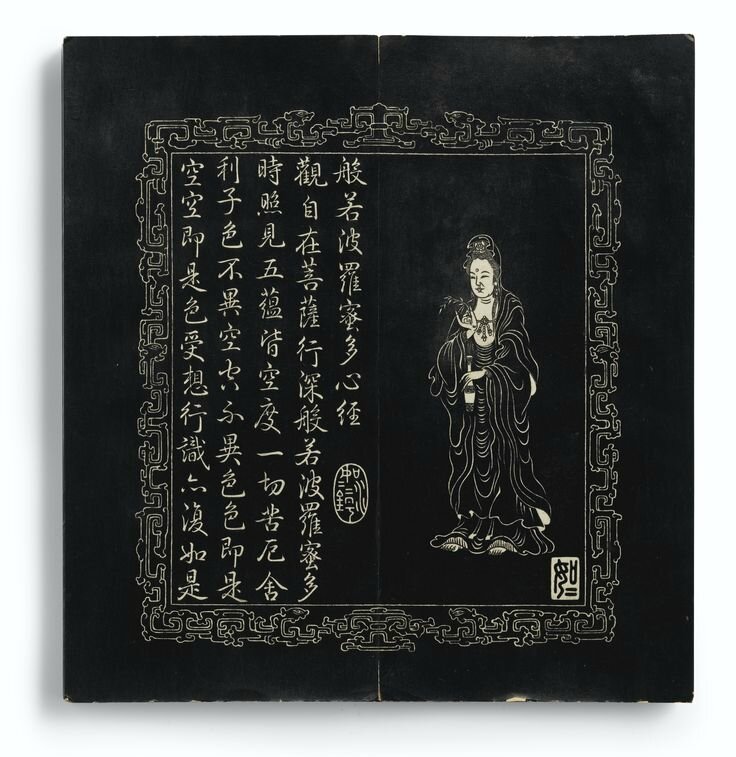An Imperial rubbing of the Prajnaparamita Sutra, Qing dynasty, Qianlong period, dated to 1775
Lot 3109. An Imperial rubbing of the Prajnaparamita Sutra, Qing dynasty, Qianlong period, dated to 1775; 27.5 cm., 10 7/8 in. Estimate 800,000 — 1,000,000 HKD. Lot sold 1,250,000 HKD (161,250 USD). Photo Sotheby's.
rubbing of the Qianlong Emperor's copy of the Xinjing (Prajnamaramitra Sutra, or 'Heart Sutra') dated to thexinwei year, corresponding to 1751), calligraphy in xingshu (running script), rubbed on five sheets of black paper within a border of archaistic kui dragons, followed by a four-page colophon, with a separate frontispiece depicting Guanyin, each page mounted in the form of an album between zitan wood covers and yellow paper with gold flecking, the cover incised and gilded with the title Yushu banruo Poluomi duo xinjing('Prajnamaramitra sutra by his Majesty'), repeated on an outer zitan wood box.
Provenance: Sotheby's Hong Kong, 23rd October 2005, lot 382.
Note: The Prajnaparamita sutra (Xinjing or Heart Sutra) was translated in the 7th century by the pilgrim monk Xuanzang on the orders of Emperor Gaozong (r. 649-683 AD). The Heart Sutra, propagating total denial of reality of the phenomenal world, is one of the most important Mahayana texts and became a popular text for copying, probably partly due to its brevity. Such copying had the dual function of serving as a calligraphic exercise and representing an act of devotion.
The Qianlong Emperor was a devout Buddhist and is known to have himself copied the Heart Sutra countless times. The present book encloses a rubbing of a stele carved with the Emperor’s own calligraphic rendering of the text executed in thexinwei year (1751). In the 40th year of his reign, he commissioned a rubbing of it to be taken to which a colophon was added.
Various other objects were ordered by the Qianlong Emperor to be carved with the text, see for example a jade book carved with the text formerly in the collection of the Empress Dowager Cixi and now in the Chester Beatty library, illustrated by W. Watson, Chinese Jade Books in the Chester Beatty Library, Dublin, 1963, no. 2, p.24, another example with a zitan wood cover sold in these rooms, The Dragon Emperor, 31st October 2004, lot 6, as well as a smaller version sold at Christie’s Hong Kong, 26th April 2004, lot 988.
Sotheby's. Imperial Porcelain and Works of Art from a Hong Kong Private Collection, Hong Kong, 07 april 2015, 10:15 AM

/https%3A%2F%2Fprofilepics.canalblog.com%2Fprofilepics%2F1%2F0%2F100183.jpg)
/https%3A%2F%2Fstorage.canalblog.com%2F03%2F02%2F119589%2F96711876_o.jpg)
/https%3A%2F%2Fstorage.canalblog.com%2F11%2F31%2F119589%2F94773502_o.jpg)
/https%3A%2F%2Fstorage.canalblog.com%2F20%2F83%2F119589%2F94772815_o.jpg)
/https%3A%2F%2Fstorage.canalblog.com%2F26%2F72%2F119589%2F75604929_o.jpg)
/https%3A%2F%2Fstorage.canalblog.com%2F59%2F60%2F119589%2F26458628_o.jpg)




/http%3A%2F%2Fstorage.canalblog.com%2F98%2F98%2F119589%2F129097971_o.jpg)
/http%3A%2F%2Fstorage.canalblog.com%2F93%2F75%2F119589%2F128489120_o.jpg)
/http%3A%2F%2Fstorage.canalblog.com%2F09%2F29%2F119589%2F128488304_o.jpg)
/http%3A%2F%2Fstorage.canalblog.com%2F62%2F18%2F119589%2F128488091_o.jpg)